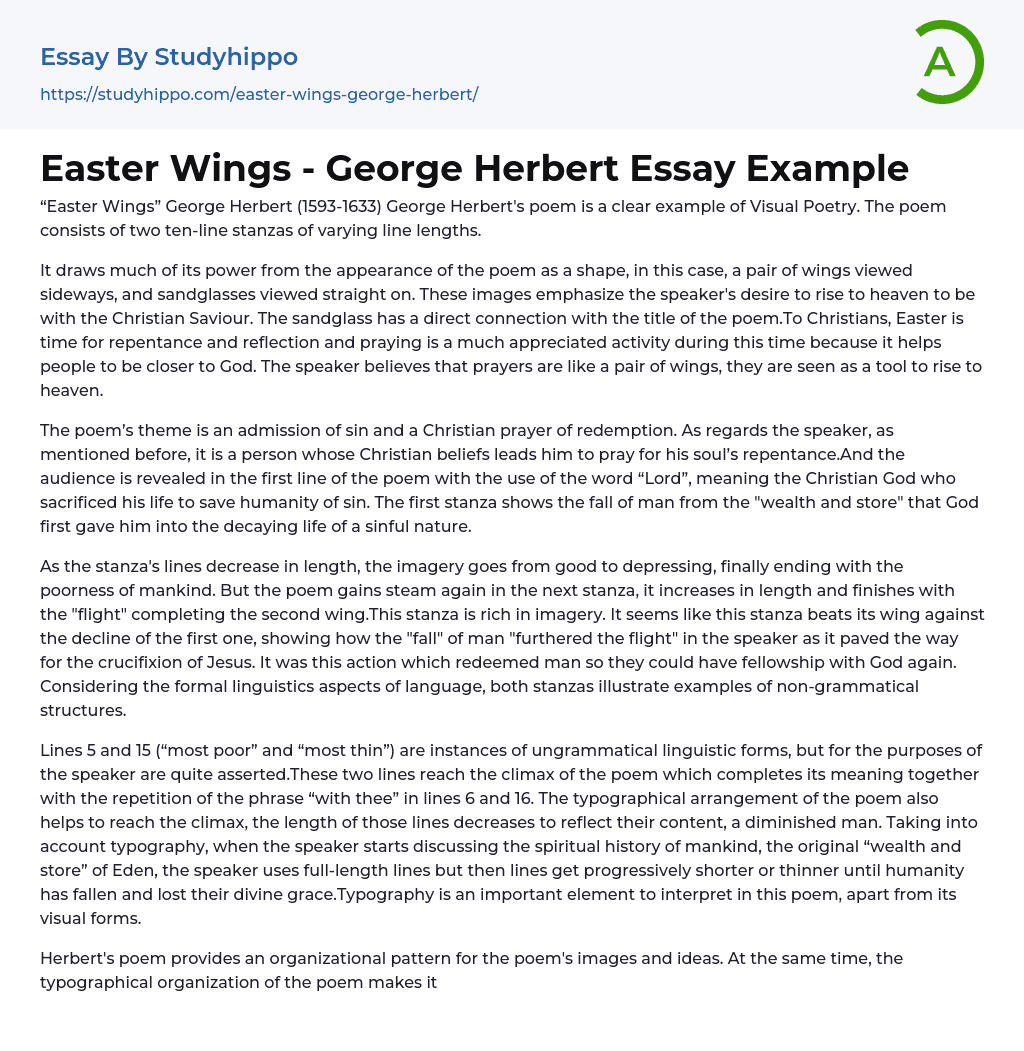"Easter Wings" by George Herbert (1593-1633) is a prime illustration of Visual Poetry. It comprises of two stanzas, each having ten lines with distinct line lengths.
By taking the shape of a pair of wings and sandglasses, this poem gains much of its power. These visual representations highlight the speaker's longing to ascend to heaven and unite with the Christian Saviour. The sandglass relates directly to the title of the piece, while Easter serves as a time for introspection and atonement for Christians. During this period, prayer is particularly valued for its ability to strengthen one's connection with God. The speaker compares prayers to wings, as they provide a means to soar towards the heavens.
The main theme of the poem is the acknowledgement of wrongdoing and a Christian plea for absolution. The speaker is a perso
...n of Christian faith who seeks forgiveness for their sins. The intended audience is addressed as "Lord" in the first line, referring to the Christian God who sacrificed himself to save humanity from sin. In the first stanza, the poem depicts the descent of humanity from a state of abundance and prosperity granted by God into a life of moral decay caused by sin.
The imagery in the stanza deteriorates as the lines become shorter, ultimately culminating in the poverty of humanity. However, in the succeeding stanza, the poem gains momentum as it lengthens and concludes with the "flight" that completes the second wing. This stanza boasts vivid imagery and appears to combat the declivity of the first stanza, illustrating how mankind's "fall" propelled the speaker's flight and paved the way for Jesus' crucifixion, an act that redeemed ma
and allowed them to once again commune with God. Both stanzas exemplify non-grammatical structures when viewed through a formal linguistic lens.
The text states that lines 5 and 15 of the poem use ungrammatical forms but are nevertheless strongly emphasized by the speaker. Together with the repetition of “with thee” in lines 6 and 16, these two lines constitute the poem’s climax and convey the idea of a diminished human being. The poem’s typography also reflects this development, as the length of lines decreases progressively after the depiction of Eden’s original “wealth and store” until humanity’s fall from grace. As such, the poem’s visual form is a crucial component of its interpretation.
By utilizing both organizational patterns of images and ideas within the poem and the typographical organization, Herbert's poem effectively distinguishes the sinful nature of humanity. The intentional use of form serves as another means to achieve the speaker's ultimate goal.
- Baptism essays
- Holy Spirit essays
- Jesus Christ essays
- Adam And Eve essays
- Crucifixion Of Jesus essays
- Crusades essays
- Eucharist essays
- God The Father essays
- Pope essays
- Protestantism essays
- Christian essays
- Church essays
- Elizabeth essays
- Sacrament essays
- Catholic Church essays
- Lord essays
- Priest essays
- Protestant Reformation essays
- Afterlife essays
- Atheism essays
- Bible essays
- Buddhism essays
- Christian Worldview essays
- Christianity essays
- Confession essays
- Cosmological Argument essays
- Deism essays
- Devil essays
- Existence of God essays
- Faith essays
- Freedom Of Religion essays
- God essays
- Hinduism essays
- Immortality essays
- Islam essays
- Jainism essays
- Jews essays
- Judaism essays
- Miracle essays
- Monk essays
- Monotheism essays
- New Testament essays
- Old Testament essays
- Pilgrimage essays
- Puritans essays
- Revelation essays
- Ritual essays
- Salvation essays
- Sin essays
- Sinners essays




